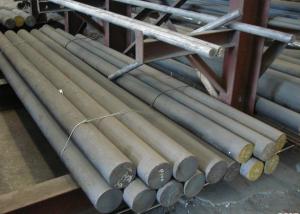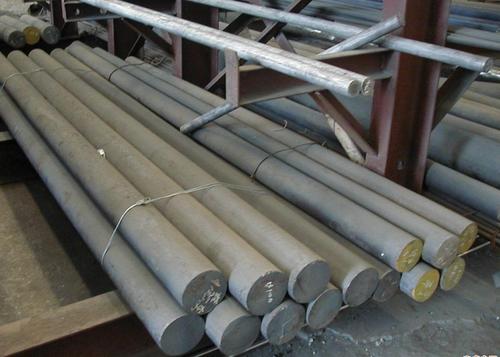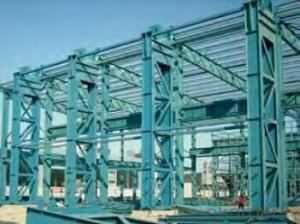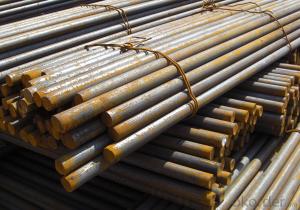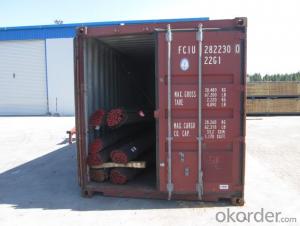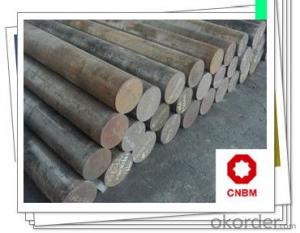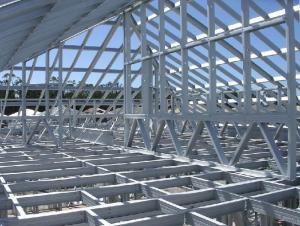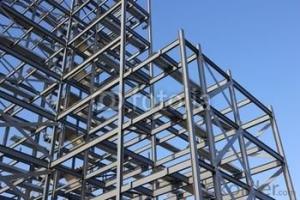Steel Round Bar Products
- Loading Port:
- Tianjin
- Payment Terms:
- TT or LC
- Min Order Qty:
- 25 Tons m.t.
- Supply Capability:
- 50000 tons per month m.t./month
OKorder Service Pledge
OKorder Financial Service
You Might Also Like
Specifications of Steel Round Bar Products
1. Grade: Q235, A36, SS400, S235JR
2. Feature: Unbreakable, grinding resistant and high impact value
3. Diameter: 8mm-150mm
4. Performance: Mainly for civil construction
5. Characteristics: Even hardness, no deformation, no breaking, no mal-roundness
6. Technique: Hot rolled
7. Mass: Mass (kg/m) = Diameter (mm) × Diameter (mm) × 0.00617
Usage and Applications of Steel Round Bar Products
1. Steel round bar products is used in construction and a large number of architectural and engineering structures. And it can be used in production of handrail, windows, machinery, telecom and curtain wall.
2. It can be used in the fields like metal mines, cement plants, water coal slurry, power stations and chemical industry.
3. Besides, we can supply some especial material steel round bar that can be used for main shaft of steamer, hummer shank, with big section and supper force.
4. Recommended watchcase factory, screw factory and other cold stamping products industry use.
Packaging & Delivery of Steel Round Bar Products
Packaging Detail: All goods are packed in bundle with steel strips and shipped by break bulk vessel or container (depend on target market and different ports)
Delivery Detail: 45 days
Trade terms: FOB, CFR, CIF
MOQ: 25 tons per specification; we can negotiate the quantity if the specification is normal or we have stock of one specification.
Weight: The price invoicing on theoretical weight basis or actual weight basis depends on customer’s request.
Shipment: The shipment of bulk break or container is depends on customer’s request and the situation of the port of destination.
Documents given: Full set of original clean on board bill of lading; Original signed commercial invoice; Original packing list; Policy of insurance; Certificate of origin and what the target market needs.
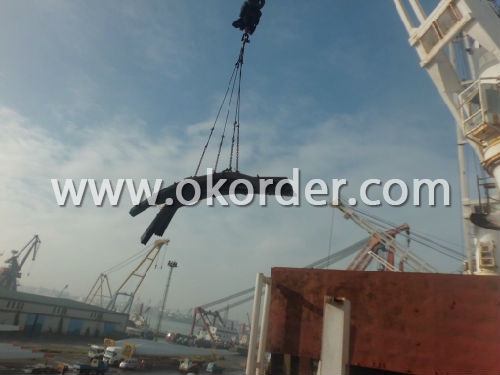

Production Flow of Steel Round Bar Products
Material prepare (billet) — heat up — rough rolling — precision rolling — cooling — packing — storage and transportation
Characteristics of Steel Round Bar Products
1. The steel in which the main interstitial alloying constituent is carbon in the range of 0.12–2.0%.
2. As the carbon percentage content rises, steel has the ability to become harder and stronger through heat treating; however it becomes less ductile.
3. Regardless of the heat treatment, higher carbon content reduces weld ability. In carbon steels, the higher carbon content lowers the melting point.
4. Quality should be in conformity with the specification of the manufacturer. Quantity and packing conditions should be in conformity with the term in the contract.
- Q: How do steel structures behave under dynamic loads such as vibrations or earthquakes?
- Steel structures are known for their excellent behavior under dynamic loads such as vibrations or earthquakes. Due to their high strength and ductility, steel structures can effectively absorb and dissipate the energy generated by these loads. This allows them to undergo significant deformations without experiencing catastrophic failure, ensuring the safety of occupants and minimizing damage to the structure. Additionally, steel's inherent resilience and ability to flex also help in reducing the amplification of dynamic loads, making it an ideal material for structures in seismic-prone areas.
- Q: How are steel structures designed to accommodate building services or utilities?
- Steel structures are designed to accommodate building services or utilities through the inclusion of various features such as service holes, utility trenches, and support systems. These features allow for the installation and integration of electrical, plumbing, HVAC, and other building services within the steel framework. Additionally, the design considers load-bearing capacities, accessibility, and maintenance requirements to ensure seamless integration and functionality of the building services within the steel structure.
- Q: What is the difference between a steel building and a steel hospital?
- The main difference between a steel building and a steel hospital lies in their purpose and design. While a steel building can be any structure made primarily of steel, a steel hospital specifically refers to a healthcare facility constructed using steel as the primary structural material. Steel hospitals are specifically designed to meet the unique requirements of healthcare, such as accommodating medical equipment, providing sterile environments, and ensuring the safety and well-being of patients and staff.
- Q: What are the common misconceptions about steel structures?
- There are several common misconceptions about steel structures that need to be clarified. One common misconception is that steel structures are not as durable as concrete structures. In reality, steel structures are incredibly durable and can withstand extreme weather conditions, seismic activity, and even fire. Steel is known for its strength and resilience, making it an excellent choice for construction. Another misconception is that steel structures are more expensive than other construction materials. While steel may have a higher initial cost, it is important to consider the long-term benefits. Steel structures require less maintenance and have a longer lifespan compared to other materials. Additionally, steel is recyclable, making it an environmentally friendly choice. Some people also believe that steel structures are not aesthetically pleasing. However, with advancements in design and technology, steel structures can be customized to fit any architectural style and can be visually appealing. The flexibility of steel allows for unique and innovative designs, making it a popular choice among architects and designers. Lastly, there is a misconception that steel structures are noisy and prone to rust. While it is true that steel can produce noise when it expands and contracts due to temperature changes, proper insulation and soundproofing techniques can minimize this issue. Moreover, steel structures can be coated with protective finishes to prevent rust and corrosion, ensuring their longevity. Overall, it is important to dispel these misconceptions and recognize the many advantages of steel structures. They offer durability, cost-effectiveness, aesthetic appeal, and sustainability, making them a popular choice in the construction industry.
- Q: How are steel structures designed for resisting progressive collapse?
- To resist progressive collapse, steel structures are engineered with a combination of robustness, redundancy, and ductility. Robustness pertains to a structure's ability to endure unforeseen loads or failures without collapsing. In the case of steel structures, robustness is achieved by designing connections and members with ample strength and stiffness to redistribute loads in the event of local failures. This involves ensuring columns and beams possess sufficient strength and designing connections between them to withstand intense forces. Redundancy is another crucial element in designing steel structures that can resist progressive collapse. Redundancy involves incorporating multiple load paths within the structure so that if one element fails, the load can be redirected to other elements. This is accomplished by creating alternative load paths through redundant members or systems, such as multiple columns or beams that can share the load in the event of failure. Ductility refers to the capacity of a material or structure to undergo deformation without fracturing. In the context of steel structures, ductility plays a significant role in resisting progressive collapse as it enables the structure to absorb energy and redistribute loads during a failure. Ductile materials like steel can undergo substantial deformations before failure, which aids in preventing the spread of localized failures and subsequent collapse. Designing steel structures to resist progressive collapse also necessitates consideration of potential causes such as blast or impact loads. These loads can lead to localized failures that trigger progressive collapses. Consequently, the design must account for the effects of these loads and ensure the structure can withstand them without collapsing. In conclusion, steel structures are meticulously designed to resist progressive collapse by incorporating robustness, redundancy, and ductility into their design. This ensures the structure can withstand unexpected loads or failures and prevent the collapse from spreading further.
- Q: What are the design considerations for steel waste management facilities?
- Design considerations for steel waste management facilities include: 1. Structural Integrity: Steel waste management facilities must be designed to withstand the weight and impact of the waste materials being stored or processed. The structure should be able to support heavy machinery and equipment used in waste management operations. 2. Corrosion Resistance: Steel structures in waste management facilities are exposed to various corrosive elements, such as chemicals and moisture. Therefore, the design should incorporate corrosion-resistant materials, coatings, or protective measures to ensure the longevity of the facility. 3. Ventilation and Odor Control: Proper ventilation systems are crucial to control odors and prevent the buildup of hazardous gases in waste management facilities. The design should include adequate ventilation systems that comply with health and safety regulations, ensuring a safe working environment for employees and minimizing odors that could impact nearby communities. 4. Waste Segregation and Storage: The layout and design of the facility should consider the efficient segregation and storage of different types of waste. This may involve separate areas for hazardous, non-hazardous, or recyclable waste, as well as proper labeling and signage to ensure waste is stored correctly. 5. Fire Safety: Waste materials can be highly flammable and pose a significant risk of fire. The design should include fire detection and suppression systems, as well as fire-resistant construction materials to minimize the spread of fire and protect the facility, surrounding areas, and personnel. 6. Accessibility and Safety: The design should prioritize safe and accessible pathways for employees and waste management vehicles. This includes considering the flow of traffic within the facility, providing appropriate loading and unloading areas, and ensuring proper access for emergency vehicles. 7. Environmental Impact: Steel waste management facilities should be designed with sustainability and environmental impact in mind. This may include incorporating energy-efficient systems, waste recycling processes, and water conservation measures. Additionally, the facility should comply with environmental regulations and minimize the risk of pollution or contamination. 8. Future Expansion and Flexibility: The design should account for potential future growth or changes in waste management operations. This may involve considering the facility's scalability, modular construction, or flexible layouts to accommodate future expansion or modifications. Overall, the design of steel waste management facilities should prioritize safety, efficiency, and environmental responsibility while meeting regulatory requirements and industry best practices.
- Q: What are the different types of steel columns used in construction?
- Some of the different types of steel columns used in construction include H-shaped columns, I-shaped columns, box columns, and circular columns.
- Q: What is the difference between a steel building and a steel hospital?
- The main difference between a steel building and a steel hospital lies in their purpose and design. A steel building is a general term used to describe any structure made predominantly of steel materials. These buildings can serve a variety of purposes such as offices, warehouses, or residential spaces. Steel buildings are known for their durability, versatility, and cost-effectiveness. They can be designed to accommodate different architectural styles and can be easily modified or expanded as needed. On the other hand, a steel hospital is a specific type of steel building designed and constructed to meet the unique requirements of a healthcare facility. Hospitals have specialized needs that must be addressed to ensure the well-being of patients and the efficiency of medical staff. These requirements include infection control measures, specific room layouts for medical equipment, easy accessibility for patients with disabilities, proper ventilation systems, and enhanced fire safety measures. In addition to meeting these specific needs, steel hospitals also incorporate advanced technologies and infrastructure to support medical services. These may include specialized HVAC systems, medical gas supply systems, communication networks, and advanced security systems to maintain patient privacy and ensure a safe environment. Furthermore, steel hospitals often require additional features such as operating rooms, intensive care units, isolation rooms, laboratories, and diagnostic imaging facilities. These specialized areas require precise engineering and design considerations to ensure they meet the strict standards and regulations of the healthcare industry. Overall, while both steel buildings and steel hospitals are constructed using steel materials, the key difference lies in the purpose, design, and features that are specific to a healthcare facility. The design and construction of a steel hospital are tailored to meet the unique needs of medical services, patient care, and the maintenance of a safe and effective healthcare environment.
- Q: What are the fire safety considerations for steel structures?
- Fire safety considerations for steel structures include the use of fire-resistant coatings or intumescent paints, adequate fire suppression systems such as sprinklers, proper compartmentalization and fire barriers, and regular inspections and maintenance to ensure structural integrity and prevent potential fire hazards.
- Q: How do steel structures withstand extreme weather conditions?
- The inherent properties of steel as a construction material enable steel structures to withstand extreme weather conditions. Steel's strength and durability make it highly resistant to severe weather phenomena like high winds, heavy snow, and earthquakes. Efficient load distribution and transfer are key factors in the ability of steel structures to withstand extreme weather conditions. Steel's high strength-to-weight ratio allows it to support heavy loads without excessive weight, allowing for optimal load distribution and preventing stress points that could lead to failure. In addition, steel's resistance to corrosion is crucial for withstanding weather conditions such as humidity, rain, and saltwater exposure. Various methods, such as galvanization or protective coatings, can be used to protect steel structures from corrosion, ensuring their resilience and structural integrity over time. Furthermore, steel possesses excellent fire resistance properties due to its high melting point. This means it can withstand the extreme temperatures generated during fires or heat-related disasters without structural failure. Flexibility is another advantage of steel structures, as they can absorb and dissipate energy from wind loads and earthquakes. This flexibility helps prevent catastrophic failure by allowing the structure to deform and return to its original position, rather than collapsing under stress. Lastly, steel structures are designed to meet rigorous building codes and safety standards, taking into account factors like wind speeds, snow loads, and seismic activity. This ensures that they are specifically designed to withstand the weather conditions of the region they are built in. In conclusion, the strength, durability, corrosion resistance, fire resistance, flexibility, and adherence to building codes make steel an ideal material for constructing buildings that can withstand extreme weather conditions. This provides safety and security to those inside the structures.
1. Manufacturer Overview
| Location | Hebei, China |
| Year Established | 1995 |
| Annual Output Value | Above US$ 15 Million |
| Main Markets | Middle east; Southeast Asia; Africa; East Aisa |
| Company Certifications |
2. Manufacturer Certificates
| a) Certification Name | |
| Range | |
| Reference | |
| Validity Period |
3. Manufacturer Capability
| a) Trade Capacity | |
| Nearest Port | Tianjin |
| Export Percentage | 20%-35% |
| No.of Employees in Trade Department | 11-20 People |
| Language Spoken: | English; Chinese |
| b) Factory Information | |
| Factory Size: | Above 6,500 square meters |
| No. of Production Lines | 1 |
| Contract Manufacturing | OEM Service Offered |
| Product Price Range | Average |
Send your message to us
Steel Round Bar Products
- Loading Port:
- Tianjin
- Payment Terms:
- TT or LC
- Min Order Qty:
- 25 Tons m.t.
- Supply Capability:
- 50000 tons per month m.t./month
OKorder Service Pledge
OKorder Financial Service
Similar products
Hot products
Hot Searches
Related keywords
